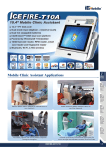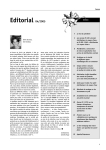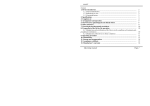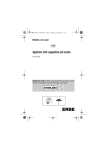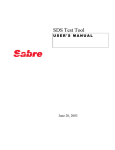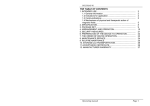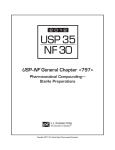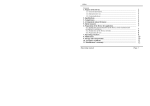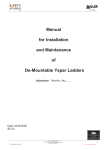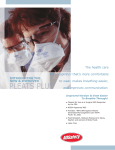Download Sterilization Wrap - Vereniging Sterilisatie
Transcript
STERILIZATION WRAP STERISHEET user guide for the validation of the packaging THE BACTERIAL BARRIER FOR HUMAN PROTECTION ARJOWIGGINS in few words… n A large range of sterilization wrap from standard creped paper to non-woven n A large range of standard or reinforced paper for sterile packaging l l Hospital pouches for Steam or EtO sterilization Packaging of single use Medical Devices for EtO and Irradiation sterilization THE BACTERIAL BARRIER FOR HUMAN PROTECTION 2 Different options of packaging… Wraps Cellulosic paper Wet laid non-woven Linen SMS (PP) Containers Pouches Cellulosic paper PEHD (flash spun bond) THE BACTERIAL BARRIER FOR HUMAN PROTECTION 3 Sterilization Wrap in details Crepe Paper 100% wood pulp material The original wrapping material and the most cost effective Reinforced Crepe Paper 80% wood pulp and synthetic surface binders The affordable combination of drape ability and softness with strength Wet Laid Non Woven 50% Wood pulp and synthetic fibers blend Binders reinforced material The higher fluid repellence, drape ability and strength for the demanding wrapping and draping applications 100% synthetics fibers PP SMS Spunbond /Meltblown / Spunbond NW The material with the highest mechanical resistance, mainly tear strength & the only material adapted to plasma sterilisation THE BACTERIAL BARRIER FOR HUMAN PROTECTION 4 How to consider the choice of packaging? n Choice of packaging shall depend on: l l l l l Type of sterilization to be used Shelf life performance to be achieved Type of material to be packed Safety of nurses, patients and for hospital environment Cost performance THE AIM: THE SAFEST OPTION FOR THE PATIENT WITH THE OPTIMAL MATERIAL n Hence the following applies: l Any elected item to wrap/pack must fulfill the objective related to operations in CSSDs: ü be sterilizable ü allow efficiency of sterilization process ü maintain barrier properties after sterilization all the way until use in OR ü proper physical protection for medical device l A careful screening of packing/wrapping options should be conducted to allow this at best possible cost performance THE BACTERIAL BARRIER FOR HUMAN PROTECTION 5 How to consider the choice of packaging? Ø Question: How to be sure that the medical device placed in the wrap packaging is still sterile when introduced in operating room ? Ø Problematic: There is no destructive and routine test able to determine if the barrier integrity of the pack is still valid Ø Answer: Compliance to EN ISO 11607 part 1 & 2 Part 1 : Requirements for material and Packaging System Design Part 2 : Validation requirements of processes for packaging 3 requested conditions: 1- Have the adequate material 2- Have a validated packaging system design 3- Follow a protocol from packaging to operating room with regular check of the integrity of the packaging THE BACTERIAL BARRIER FOR HUMAN PROTECTION 6 ISO 11607 Standard n SCOPE : Packaging for terminally sterilized medical device manufactured industrially or assembled in a CSSD n Increased responsibilities for the CSSD n Producer ≠ Manufacturer l l Producer : Arjowiggins / responsible for the material Manufacturer : CSSD in charge of the packaging and sterilization THE BACTERIAL BARRIER FOR HUMAN PROTECTION 7 ISO 11607 Standard n Packaging system = SBS (Sterile Barrier System) + Protective packaging n Number of layers for SBS? 1 layer ? 2 layers ? l Minimum package that prevents ingress of micro-organisms & allows aseptic presentation of the product at the point of use n Packaging system should consist in a SBS and a protective packaging: 2 possible ways: l l SBS made of 2 layers + 1 layer for protective packaging => Packaging system is made of 3 layers SBS made of 2 layers, outer layer playing a double part: ü Barrier ü Protection THE BACTERIAL BARRIER FOR HUMAN PROTECTION 8 1- MATERIAL REQUIREMENT 2- PACKAGING SYSTEM DESIGN REQUIREMENTS 3- PROCESSES VALIDATION THE BACTERIAL BARRIER FOR HUMAN PROTECTION 9 1- MATERIAL REQUIREMENT 2- PACKAGING SYSTEM DESIGN REQUIREMENTS 3- PROCESSES VALIDATION THE BACTERIAL BARRIER FOR HUMAN PROTECTION 10 ISO 11607-1 : Material Requirements q Example of what Arjowiggins done to be in compliance with ISO 11607-1 for material requirements q Documentation provided by the supplier Key properties to be evaluated Requirements Compliance demonstrating Tools: Standards & appropriate Test methods Microbial barrier Porous material shall provide an adequate microbial barrier Tests listed in EN 868-2 Bacterial Filtration Efficiency (ASTM F2101) Germ Proofness (DIN 58953-6 § 2.14 & § 2.15) Biocompatibility & toxicological attributes Biocompatibility Sensitisation / Irritation / Cyto-toxicity Bio-burden control Chemical properties ISO 10993 ISO 10993 EN 11737 EN 868-2 Physical & chemical properties Physical & chemical properties follow-up Tests listed in EN 868-2 Compatibility with respect to forming and sealing processes Folding Drape ability EN 868-2 EN 868-2 Compatibility with respect to the intended sterilization processes Suitability for use in sterilization processes and cycle parameters EN 868-2 after sterilization Acceptable shelf-life Any shelf-life limitations for presterilization and post-sterilization storage EN 868-2 Bacterial Filtration Efficiency (ASTM F2101) Germ Proofness (DIN 58953-6 § 2.14 & § 2.15) on 5 years aged paper, before and after sterilization THE BACTERIAL BARRIER FOR HUMAN PROTECTION 11 EN 868-2 : Sterilization wraps n Specific requirements for sterilization wrap n 4 materials are listed l Plain Paper ð cellulose base l Creped paper ð cellulose base l Non woven ð cellulose base with synthetics fibers (wet laid non woven) ð 100% synthetics fibers (dry laid non woven) l Linen ð Woven textile material THE BACTERIAL BARRIER FOR HUMAN PROTECTION 12 Role of packaging Allow sterilization AND provide a high bacterial barrier performance during the storage of the sterilized packs Sterilizing agent Micro-organisms ____________ Bacterial barrier against contamination coming from: - Air (airborne, micro particles, dust) Fluids (drops, aerosols) THE BACTERIAL BARRIER FOR HUMAN PROTECTION 13 Microbial barrier n The principle of bacterial barrier is that bacteria die / burn their energy before crossing barrier material ð Tortuous path n Part of the non-compliant materials are the ones which are not barrier enough to stop bacteria on their way ü Film to paper pouches poorly manufactured (no sealing in some areas) ü Materials with holes or with insufficient tortuous path THE BACTERIAL BARRIER FOR HUMAN PROTECTION 14 Microbial barrier Germ Proofness DIN 58953-6 § 2.15 dry challenge test § 2.14 wet challenge test Pass or fail test performed on sterilized sample THE BACTERIAL BARRIER FOR HUMAN PROTECTION 15 Microbial barrier Germ Proofness DIN 58953-6 § 2.15 dry challenge test Simulates exposure to airborne bacteria by placing a microorganisms powder in contact of a pressurized / depressurized sample. Then are counted the microorganisms passing trough the sample on a nutrient medium placed on the opposite side Bacteria POWDER MATERIAL PAPER or LINEN AIR FLOW Sample Agar medium THE BACTERIAL BARRIER FOR HUMAN PROTECTION 16 Microbial barrier Germ Proofness DIN 58953-6 § 2.14 wet challenge test Simulates exposure to liquid-borne bacteria by placing few microorganisms aqueous droplets in contact of a sample. After drying & incubation are counted the microorganisms passing trough the sample on a nutrient medium placed on the opposite side Bacteria DROPLETS MATERIAL PAPER or LINEN Sample Agar medium THE BACTERIAL BARRIER FOR HUMAN PROTECTION 17 Microbial barrier Bacterial Filtration Efficiency test (ASTM F2101) A microorganisms suspension is dried and sprayed onto the sample. A constant air flow then draws the sprayed microorganisms through the sample. The number of them that have passed through the sample is counted in a nutrient medium placed on the other side. BFE test performed on material after steam sterilization to simulate exposure to airborne bacteria BFE testing: 100% is the best possible rating THE BACTERIAL BARRIER FOR HUMAN PROTECTION 18 Microbial barrier Test performed on 1 single sheet DRY STATE Germ Proofness WET STATE Bacterial Filtration Efficiency Germ Proofness Water resitance EN 868-2 Annex B Arjowiggins - crepe paper PASS 96% to 99% PASS 30s Arjowiggins - Wet laid non woven PASS 90% PASS >75 min Mason Jarr Arjowiggins - SMS PASS 93% PASS >75 min Mason Jarr THE BACTERIAL BARRIER FOR HUMAN PROTECTION 19 Sterilization processes - compatibility Steam sterilization is the way the most used q Steam q Formaldehyde q EtO q Irradiation q Plasma THE BACTERIAL BARRIER FOR HUMAN PROTECTION 20 Sterilization processes - compatibility 100 % steam penetration as percentage of activated sterilization indicators according to ISO 11134 Cycles: France USA Steam sterilization is the way the most used 18’ @ 134°C 20’ @ 121°C THE BACTERIAL BARRIER FOR HUMAN PROTECTION 21 Sterilization processes - compatibility Packaging Material wrap Cellulosic crepe paper Wet laid non-woven SMS (100% PP) Linen pouches Cellulosic paper Tyvek container STEAM EtO P P P P P P P P P P P Irradiation Plasma FO P P P P P P P P P P P depending of the type of filter THE BACTERIAL BARRIER FOR HUMAN PROTECTION 22 Topics 1- MATERIAL REQUIREMENT 2- PACKAGING SYSTEM DESIGN REQUIREMENTS 3- PROCESSES VALIDATION THE BACTERIAL BARRIER FOR HUMAN PROTECTION 23 ISO 11607-1 : Packaging System Design Requirements Condition 1 : Check if the product is normalized (ISO 11607-1 & EN 868-2), answering the following needs: - Microbial barrier properties - Biocompatibility & non toxicity products - Sterilization process compatibility - Acceptable shelf life Condition 2 : Validation of the packaging system design Key properties to be evaluated Requirements Opening Aseptic presentation Compatibility with respect to the intended sterilization processes Efficiency of sterilization Packaging system physical protection Adequate protection to the product through the hazards of handling, distribution and storage Packaging system microbial barrier Integrity of the Sterile Barrier System Stability testing Maintenance of sterility integrity over time Compliance demonstrating Tools Appropriate Solutions: REAL TESTS & GOOD PRACTICES THE BACTERIAL BARRIER FOR HUMAN PROTECTION 24 How to validate that the design of your packaging system is adapted ? Condition 2 : Validation of the packaging system design by real test & good practices Ø Several wrapping methods - Envelope folding - Square folding - Pasteur folding - Roll method Ø The most common and recommended folding is envelope folding Ø Why? - To create the more tortuous path which means a better barrier against penetration of micro-organism Design validated by Event-Related Sterility Maintenance Study - Reduce handling during opening thanks to the tab THE BACTERIAL BARRIER FOR HUMAN PROTECTION 25 How to validate that the design of your packaging system is adapted ? Ø Double sequential wrap is recommended Ø Why? - Bacterial filtration efficiency & germproof ness test (DIN 58953-6 § 2.14 & § 2.15) is improved - Guarantee aseptic opening - Possibility to combine different generation wraps and offer a combination of the best characteristics and benefits of each generation of products - Provide the most adapted wrapping solution and a tailored made wrapping system - Possibility to have a colour coding : Security : Superposition of two colours allows to visualise any defect & prevent dust cover 26 THE BACTERIAL BARRIER FOR HUMAN PROTECTION entering the operation rooms Validation of the double wrapping Vs single wrapping Bacterial Filtration Efficiency test (ASTM F2101) Single Wrapping Double Wrapping (interleaved) 96% to 99% 99,9% Arjowiggins - Wet laid non woven 90% 98% Arjowiggins - SMS 93% 99% Arjowiggins - crepe paper THE BACTERIAL BARRIER FOR HUMAN PROTECTION 27 How to validate that the design of your packaging system is adapted ? Condition 2 : Validation of the packaging system design by real test & good practices Ø Efficiency of sterilization : Steam penetration testing thru activating sterilization indicators Ø Integrity of the SBS / Maintenance of sterility integrity over time : Event-Related Sterility Maintenance Study (Nelson laboratories) This test is performed on double-layer packaging after sterilization, and simulates shelf storage – inside a room whose humidity and temperature are regularly recorded – along with weekly handling of the packaged packs. The packs are inspected after period of 180 days and the results is given as the percentage of uncontaminated packs. Microbial aerosol challenge test (Nelson laboratories) aerosolizing high number of Bacillus atrophaeus spores and then testing the contents of the package for ingression of that organism THE BACTERIAL BARRIER FOR HUMAN PROTECTION 28 Validation of sterility maintenance Event-Related Sterility Maintenance Study Wraps Sterility Maintenance (30 days / 180 days) Sterisheet Creped Paper 100 % / 100% Sterisheet Reinforced Creped Paper 100 % / 100% Sterisheet Wet Laid Non Woven 100 % / 100% Sterisheet SMS 100 % / 100% Tested on double sequential wrapping THE BACTERIAL BARRIER FOR HUMAN PROTECTION 29 Topics 1- MATERIAL REQUIREMENT 2- PACKAGING SYSTEM DESIGN REQUIREMENTS 3- PROCESSES VALIDATION THE BACTERIAL BARRIER FOR HUMAN PROTECTION 30 Our protocol for the validation of packaging process Condition 1 : Check if the product is normalized (EN ISO11607-1 & EN 868-2), answering the following needs: Condition 2 : Validation of the packaging system design by real test & good practices Condition 3 : A written protocol and visual aids for each step 1- Packing preparation 2- Sterilization (Loading) 3- Transportation 4- Storage 5- Opening Only a visual inspection, will guarantee the integrity of the packaging : At the end of each stage, a visual inspection should be performed thru a documented quality system including recording, training & qualifying any actor of the chain Following guideline is based on these 3 conditions and the results of in situ testing, experience & good practices THE BACTERIAL BARRIER FOR HUMAN PROTECTION 31 ISO 11607-2 : Validation of the process Ø Necessity of a quality document describing (at least) - used material, its characteristics, etc…. (supplier data) - type of sterilization used - type of Medical Device to be sterilized - folding & packing protocol - acceptation criteria - qualification step (IQ, OQ & PQ) Ø Qualification in 3 steps : 1- Installation Qualification c training / installation :table, light, wraps rack, etc… 2- Operational Qualification c check et validation that the packing is appropriate (worst case scenario) 3- Performance Qualification c repeatability and reproducibility of the process THE BACTERIAL BARRIER FOR HUMAN PROTECTION 32 Guideline for packaging 1- Packing preparation (1/4) Ø All the items must be carefully checked before packing q Medical devices • check the medical devices are clean & dry • check the medical devices are not damaged - no stain / no corrosion • check all items for a given procedure are there q Sterilization sheets • check if packaging product is clean, without any holes & tears & secure its tracking number trace ability feature • store the wraps on rack q Packing area • prepare a clear & clean area • table with an adequate surface • tape holder THE BACTERIAL BARRIER FOR HUMAN PROTECTION 33 Guideline for packaging 1- Packing preparation (2/4) Ø Chose the adapted material to the medical device • Material adapted to the size and weight of the items to be packed THE BACTERIAL BARRIER FOR HUMAN PROTECTION 34 Guideline for packaging 1- Packing preparation (3/4) Small packs Medium size packs Large Packs Orthopedic sets THE BACTERIAL BARRIER FOR HUMAN PROTECTION 35 Guideline for packaging 1- Packing preparation (2/4) Ø Chose the adapted material to the medical device • Material adapted to the size and weight of the items to be packed • Adapted to the shape of the medical device (Sharp edge, corner) • Adapted to the number of manipulations • add protection to sharp medical devices (the protections shall withstand the sterilization process) ð Place visual aids on the packing area to chose the right material THE BACTERIAL BARRIER FOR HUMAN PROTECTION 36 Guideline for packaging 1- Packing preparation (4/4) • Visual of the folding procedure in packing area • Validation (OQ) : Place sterilization indicator inside the pack to check efficiency of sterilization process • Check tack and resistance of specific sterilization indicator tape (designed to endure both heat & humidity) to close the pack good wrong • Visual of the aspect of the final pack to prevent gapping, billowing & air pockets from the forming • First validation of the packaging by comparison with visual aids • Traceability of the pack THE BACTERIAL BARRIER FOR HUMAN PROTECTION 37 Guideline for packaging 2- Sterilization (1/2) Ø Loading • Avoid the sterilization of different kinds of materials: - Textiles - Plastics - Metal - sterilization wraps - containers • Make sure all items are oriented in the sterilizer such that water can drip out: -Basins and other concave items must be placed on their sides tipped slightly downward -Pouches shall be placed vertically, in a way water can drip out • Do not overcrowd the sterilizer • Stacked packs = Tear or Puncture risk • Asperity on the support = risk of Tear THE BACTERIAL BARRIER FOR HUMAN PROTECTION 38 Guideline for packaging 2- Sterilization (2/2) ØThe choice of the cycle Sterilisation cycle shall be adjusted to the loading ØUnloading • Don’t manipulate the packs before the load is fully cooled down • Check the sterilization release parameters or indicators to validate the sterilization process • Check there is no residual condensation on each pack when unloading • Check the integrity of the protective layer : if it has been damaged, sterility state could be compromised and the pack must be processed again & Root Causes Analysis should be performed THE BACTERIAL BARRIER FOR HUMAN PROTECTION 39 Guideline for packaging 3- Transportation Ø shelf life of a package sterile is event related and not time-related • Supplies should be handled carefully • Transportation in clean cabinets, in bins or with trolleys are recommended • Avoid dragging, crushing, bending, compressing, or puncturing the packaging • Avoid multiple handling, moisture penetration and exposure to airborne contaminates • After each manipulation, packaging should be thoroughly inspected • When hand transport, sterile packages should be maintained in a position parallel with the floor • Written policies and procedures should be developed for the use of transport equipment and appropriate handling practices. THE BACTERIAL BARRIER FOR HUMAN PROTECTION 40 Guideline for packaging 4- Storage Ø shelf life of a package sterile is event related and not time-related Sterile items should be stored in a manner that reduces the potential for contamination • Storage area dedicated to sterile supplies • Temperature and humidity controlled (Room temperature & Humidity does not exceed 70%) • Away from direct sunlight • Traffic should be controlled to limit access to sterile items • Sterile items stored far enough away from the floor, the ceiling, and outside walls to allow for adequate air circulation • Avoid friction of packs against the shelves during handling • first in / first out policy •Written policies and procedures should be developed for the storage, handling and rotation. THE BACTERIAL BARRIER FOR HUMAN PROTECTION 41 Guideline for packaging 5- Opening sterile packages Ø The following guidelines should be observed when opening sterile packages: • Before it is opened, the package should be inspected for the appropriate appearance of the external sterilization indicator and the physical integrity of the packaging ð Last and more crucial inspection ð Place visual aids of final packaging & refused package in this area [closely linked to first step : packaging preparation] • Remove the outer wrap before entering the OR not to introduce exterior contaminating elements • Enter the OR with the inner wrap only ðaseptic presentation ð if the material is a non woven resistant to disinfectants, it can be used as sterile field THE BACTERIAL BARRIER FOR HUMAN PROTECTION 42 Guideline for packaging A new work Item for ISO TC 198 WG 7 Ø The crucial subject of packaging systems assembly validation taken under consideration during the last 2 plenary meeting : • Keys decisions: • Educational informative guideline to be submit to formal vote within 1 year time frame • Addressing on the same levels, both Medical Devices Manufacturers and healthcare facilities (hospital CSSD, dentists,…) needs • Covering all kind of currently used packaging systems for hospitals i. e. • Pouches • Containers • WRAPS • Clearly emphasizing the KEY need of the ASPETIC presentation of the packed products THE BACTERIAL BARRIER FOR HUMAN PROTECTION 43 Thank you for your attention THE BACTERIAL BARRIER FOR HUMAN PROTECTION 44 THE BACTERIAL BARRIER FOR HUMAN PROTECTION 45













































